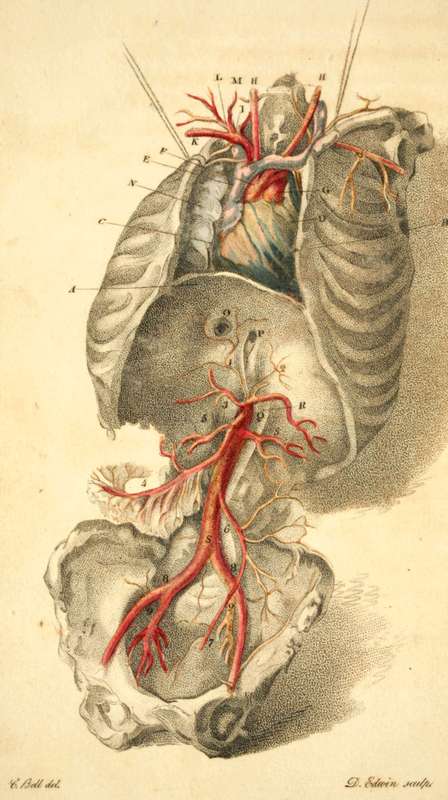Diaphragm, the Situation of the Heart, the Blood-vessels of the Breast, and the Abdominal Aorta
Description
This section is from the book "Engravings Of The Arteries", by Charles Bell. Also available from Amazon: Engravings Of The Arteries; Illustrating The Anatomy Of The Human Body, And Serving As An Introduction To The Surgery Of The Arteries.
Diaphragm, the Situation of the Heart, the Blood-vessels of the Breast, and the Abdominal Aorta
Explaining the Diaphragm, the Situation of the Heart, the Blood-vessels of the Breast, and the Abdominal Aorta.
(Bell's Anat. Vol. II.pages 245—252, and 408.) (Wistar, pages 258—261,276—277, 280,and 285.)
A. The Diaphragm, dividing the thorax from the abdomen.*
b. The Heart, lying upon the diaphragm, and with the apex obliquely to the left side.+

* A thrust made with a small sword on the left side of the chest, immediately above the seventh rib, perpendicularly to the convexity of the chest, will pass through the diaphragm into the stomach, the heart escaping.
+ A thrust immediately above the left pap, and above the fifth rib, perpendicularly to the surface of the chest, transfixed the body of the left ventricle of the heart, perforating the anterior and extreme margin of the right.
c. The Bight Auricle.
d. The Left Auricle; that which receives the blood from the lungs.
e. The Superior Vena Cava, returning the blood from the arms and head to the right auricle.
A thrust made perpendicularly to the convexity of the chest, immediately under the anterior head of the fifth rib, will pass through the anterior edge of the right lung, and pierce the apex of the heart.
Perpendicularly to the convexity of the right side of the chest, and immediately below the anterior head of the third rib, the thrust made will pierce the lungs and mediastinum, and pass through the right auricle.
A thrust perpendicularly down by the left side of the sternum, betwixt the fourth and fifth ribs, will pass through the upper part of the heart, near the root of the pulmonary artery.
A thrust perpendicularly to the convexity of the chest, immediately under the right pap, and of course the fifth rib, will pass through the root of the lungs among the great vessels.
A thrust with the small sword, horizontally from the greatest lateral convexity and upper edge of the seventh rib, will pass through the middle of the lower portion of the posterior lobe of the right lung, behind the heart, into the posterior mediastinum, where the aorta and oesophagus are about to pass through the diaphragm.
f. The Arch of the Aorta.*
g. The Pulmonic Artery.
h. The Right and Left Carotid Artery.
i. The Subclavian Artery.
k. The Internal Mammary Artery.
l. The Thyroid Artery, to the shoulder, the neck, and the thyroid gland.
m. The Vertebral Artery.
n. The Lungs of the right side.
o. The Perforation of the Diaphragm, for the transmission of the inferior cava.
p. The Hole by which the (Esophagus passes into the abdomen.
q. The Lesser Muscle of the Diaphragm. See the text, p. 325, Vol. II.
* The arch of the aorta lies three fourths of an inch below the level of the upper part of the sternum.
If the assassin strikes within the clavicle, obliquely down, with the stiletto, the point will, at the depth of , pass into the arch of the aorta, and occasion a more sudden death than if struck into the heart; if the aorta should escape, some of the great branches will be wounded; even if the great branches should escape, and the trachea be wounded, the patient is in danger of instantaneous death, from the blood passing into the trachea suffocating him.
s. The whole length of the Abdominal Aorta. It is seen embraced by the diaphragm at it., and immediately giving off the phrenic and cceliac arteries.
1. The Right Phrenic Artery.
2. The Left Phrenic Artery.
3. The Root of the Cceliac Artery, (See Plate VII.)
4. The Upper Mesenteric Artery, (See Plate VIII.)
5. The Emulgent Arteries.
6. The Lower Mesenteric Artery.
7. The Hemorrhoidal Artery, a branch of the last.
8. The Common Iliac Arteries.
9. The Internal Iliac. It is seen to give off the gluteal, the ischiatic, and obturator artery.
Continue to:
